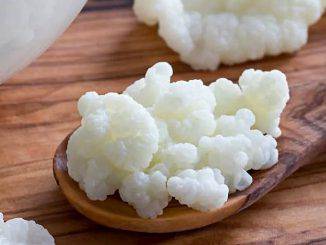
One of our readers recently asked us for advice. “I couldn’t strain my Kefir well, she said, and I may have swallowed some grains. Is it dangerous? What should I do if I ingest Kefir grains?”
While Kefir grains are safe to consume, they are not typically eaten as a standalone food. They have a rubbery texture and a sour taste, which may not be very pleasant for some people. Some people might blend grains with a smoothie or juice to make a healthy drink, but it’s not common to eat them on their own.
Additionally, note that while they are not harmful to eat, they are not particularly nutrient-dense and may not offer much nutritional benefit. They are mostly used to make the fermented drink, not to be eaten directly.
Yet, rest assured: not only you’re not running any risk by ingesting Kefir grains, but eating them can potentially be more beneficial for your health than you might think.
Since Kefir grains tend to constantly grow with each ferment, their owners sooner or later find themselves with an excess of grains. In these cases, they have the choice to either toss some of them away (strongly disadvised), give them to other Kefir lovers, or … simply eat the excess grains. Why not?
So, let’s dig deeper into the topic of eating Kefir grains, and more precisely – eating Milk Kefir grains.
What are the Kefir grains “made of”?
As we have stated numerous times throughout this website, Milk Kefir grains are symbiotic colonies of bacteria and yeasts, englobed in a matrix of polysaccharides, fibers, and proteins.
In other words, besides the bacteria and yeasts that can also be found in the Kefir brew, the Kefir grains contain, in addition, more polysaccharides (complex sugars), fibers, proteins (in the form of various peptides), lipids (fatty acids), as well as Vitamins (predominantly B Vitamins), Calcium, Phosphorus, and other easily digestible minerals.
What are the advantages of eating Kefir grains?
Here comes the first advantage of eating Kefir grains: as we wrote earlier, they contain fibers that may act as prebiotics, enhancing the activity of the probiotic bacteria and yeast of Kefir.
As we know, prebiotics are non-digestible food components, primarily fibers, that stimulate the growth of probiotic bacteria. They are actually the food and vital support of the probiotics.
In other words, beyond probiotic bacteria and yeasts, Kefir grains also carry the food for these bacteria and yeasts that enhance and boost their probiotic powers.
Another big advantage of eating Kefir grains (compared to drinking plain Kefir) is that their external matrix of polysaccharides, fibers, and proteins actually shields the bacteria of Kefir and protects them from the harsh, highly acidic environment in the stomach.
You see, the place where the probiotic bacteria of Kefir belong, and where they do their beneficial job for our health, is the intestines. To reach the intestines, however, the bacteria and yeast of Kefir must survive the extremely acidic environment of the stomach, able to decompose even bone tissue. In real life, on average no more than 40% of the bacteria and yeast of plain Kefir survive this ordeal and reach alive their final destination – the intestines.
The good news is that once they reach their destination, they colonize the intestines and start to multiply. So, even only 40% of them are largely sufficient to ensure their beneficial effects on our health.
On the other hand, when shielded by the protective matrix of the Kefir grains, the probiotic bacteria of Kefir have higher chances of surviving the stomach acids and reaching the intestines alive. By the way, the pharmaceutical industry uses this same method for most pills intended to treat intestinal diseases. They are coated by a thin layer of an acid-resistant substance that protects them from gastric acids until they reach the intestines.
So, a larger portion of the probiotic bacteria usually reaches the intestines, when they are protected by the shielding layers of the Kefir grains.
What could be the downsides of eating Kefir grains?
Objectively, eating Kefir grains has no downsides, except for … some personal preferences, especially the way they taste.
Honestly (and personally) speaking, after trying them multiple times, I may say that they taste like rubber, and the feel of chewing rubber is not particularly appealing. I don’t mean they taste bad, since their taste is similar to Kefir itself, but with this added weird sensation of masticating pieces of rubber.
Moreover, several studies suggest that Kefir grains actually don’t carry more probiotic bacteria and yeast than regular Kefir.
Instead, Kefir grains usually contain slightly more yeast, but considerably fewer probiotic bacteria than Kefir itself. So, the perception that when you eat grains, you eat some kind of “Kefir concentrate” is entirely wrong. In fact, the Kefir grains may contain more fiber and protein, but less probiotic bacteria.
Ways to “counteract” that rubbery taste
If you insist on eating Kefir grains, there are ways to get rid of this weird gummy sensation in the mouth, while keeping the positive effects of eating the grains.
If you don’t really like the idea of eating them (like me), you can put them in a blender and blend them with some fruit until you get a smooth paste that could be used in smoothies, ice creams, salad dressings, or for baking Kefir cookies.
The claim that the blender somehow “crushes” and “destroys” the probiotic bacteria in Kefir grains is completely wrong. The bacteria are just too small to be affected by even the sharpest blender blades.
Finally, should we eat Kefir grains?
If you feel like it, eat them at your will. Not only does eating Kefir grains involve no risk, but it may be very beneficial for your health.
On the other hand, if you asked me whether you should, by all means, eat Kefir grains, my answer would be: probably not.
Regular consumption of plain, well-fermented Kefir, is largely sufficient for all your needs of probiotics, and additional intake of Kefir grains will hardly add any substantial value.
If you have any extra Kefir grains you don’t really need, you may eat them or share them with friends. Alternatively, you may desiccate and freeze them for later use. Only, please, do not throw them away. That would be a pity.
Summary
Eating Kefir grains is not only completely harmless for anyone that likes Kefir, but could also have some additional benefits for the health.
Eating Kefir grains has at least two advantages over eating plain Kefir.
- Grains contain fibers that may act as prebiotics and boost the probiotic powers of Kefir bacteria and yeasts.
- Grains provide an additional protective layer to Kefir’s probiotic bacteria that shields them from the strong stomach acids. In this way, a larger portion of bacteria can reach the intestines where they actually belong and where they can deploy their real probiotic powers.
On the other hand, the downsides of eating Kefir grains are their weird rubbery taste and the fact that they actually contain fewer probiotic bacteria than regular Kefir. As a result, eating Kefir grains doesn’t really add any substantial value compared to the consumption of plain milk Kefir.
Regular consumption of plain, well-fermented Kefir, is largely sufficient for all your body’s needs of probiotics.
Related questions
-
Are there any other precautions that should I take before eating Kefir grains?
Consumption of any live bacteria should always be considered with care, and all Kefir-related products (grains included) make no exception. All considerations connected to the intake of Kefir remain equally valid for the consumption of Kefir grains. -
I see a slimy substance that covers the Kefir grains. Can I eat it or should I rinse it out before eating the grains?
The “slimy substance” that usually covers the Kefir grains is called Kefiran and is one of the most valuable assets of Kefir. Kefiran mostly contains the main bacteria of Kefir – Lactobacillus kefiranofaciens, and it not only provides a “natural habitat” to all other Kefir bacteria, but also provides a series of substantial direct health benefits like lowering blood pressure, reducing inflammation, reducing cholesterol, and increasing production of interferon which is an integral part of the anti-viral defenses of our bodies. So, when possible, avoid rinsing Kefiran out of the grains, no matter whether you intend to eat the grains or make a new batch of Kefir. Kefiran is just too precious to be rinsed out.
Related resources
- Kefir pros and cons
- Can Kefir help with Candida infections?
- Can Kefir help with high blood pressure?
- Can Kefir help with acid reflux?
- Can Kefir help with SIBO treatment?
- Is Kefir good for osteoporosis?
- Can Kefir help with IBS?
- Can Kefir help with antibiotics?
- Is Kefir safe during pregnancy?
- Is Kefir safe while breastfeeding?
- Can Kefir help with diabetes?
- Can Kefir help with weight loss?
- Possible dangers of Kefir
- Tools and kitchenware you need for your homemade Kefir



